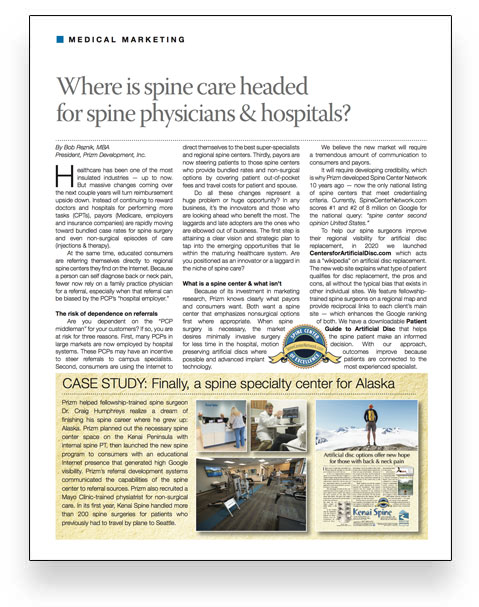Celebrating 30 years as the nation’s most experienced developer of spine & orthopedic centers of excellence.
- 817-481-2450
- Contact Us
-
About PRIZM
In the News
January 28, 2020 — Prizm launches Centers for Artificial Disc to help consumers learn the pros and cons of artificial disc replacement in both the cervical and lumbar spine.
The new national site at CentersforArtificialDisc.com features spine surgeons on a map of the United States who are trained in artificial disc replacement so consumers can locate a spine center near them that is proficient in the latest treatment alternative to spinal fusion.
The goal of the Centers for Artificial Disc is to provide a BALANCED VIEW of disc replacement so consumers have a clear understanding of the pros and cons of disc replacement, the considerations of spine surgeons in recommending or NOT recommending disc replacement and WHEN it is appropriate.
"Sadly, a lot of information on the Internet can be biased toward or against disc replacement," explains Bob Reznik, MBA, president of Prizm and the main architect of the umbrella Internet site. "With any new technology there can be resistance to change, and bias based on if a surgeon is trained and proficient in artificial disc replacement because it is a new skill. There is also bias related to specific implants. Prizm’s philosophy has always been that the best healthcare comes from an educated health care consumer. For example, for someone who has just been told that the numbness in their fingers is from a herniated disc in their neck, and that they need a spinal fusion, it’s important for them to know that there may qualify for new technology that preserves the natural motion in their neck. And that an artificial disc may save them from a second surgery caused by adjacent segment disease. But it their spine surgeon doesn’t know how to perform that surgery, or is uninformed about the benefits, the patient may never find that out. This site can be an educational resource for that patient."
Reznik notes that the Centers for Artificial Disc site covers the various disc technology currently available, the FDA approved discs, and other new technology on the horizon coming soon to the U.S. The educational site also explains which patients qualify for disc replacement and why certain cases are not appropriate for disc replacement.
More information about cervical and lumbar artificial disc replacement is at CentersforArtificialDisc.com.
September 4 2019 — SpineCenterNetwork.com recommends home remedy book & non-surgical treatment options for back pain
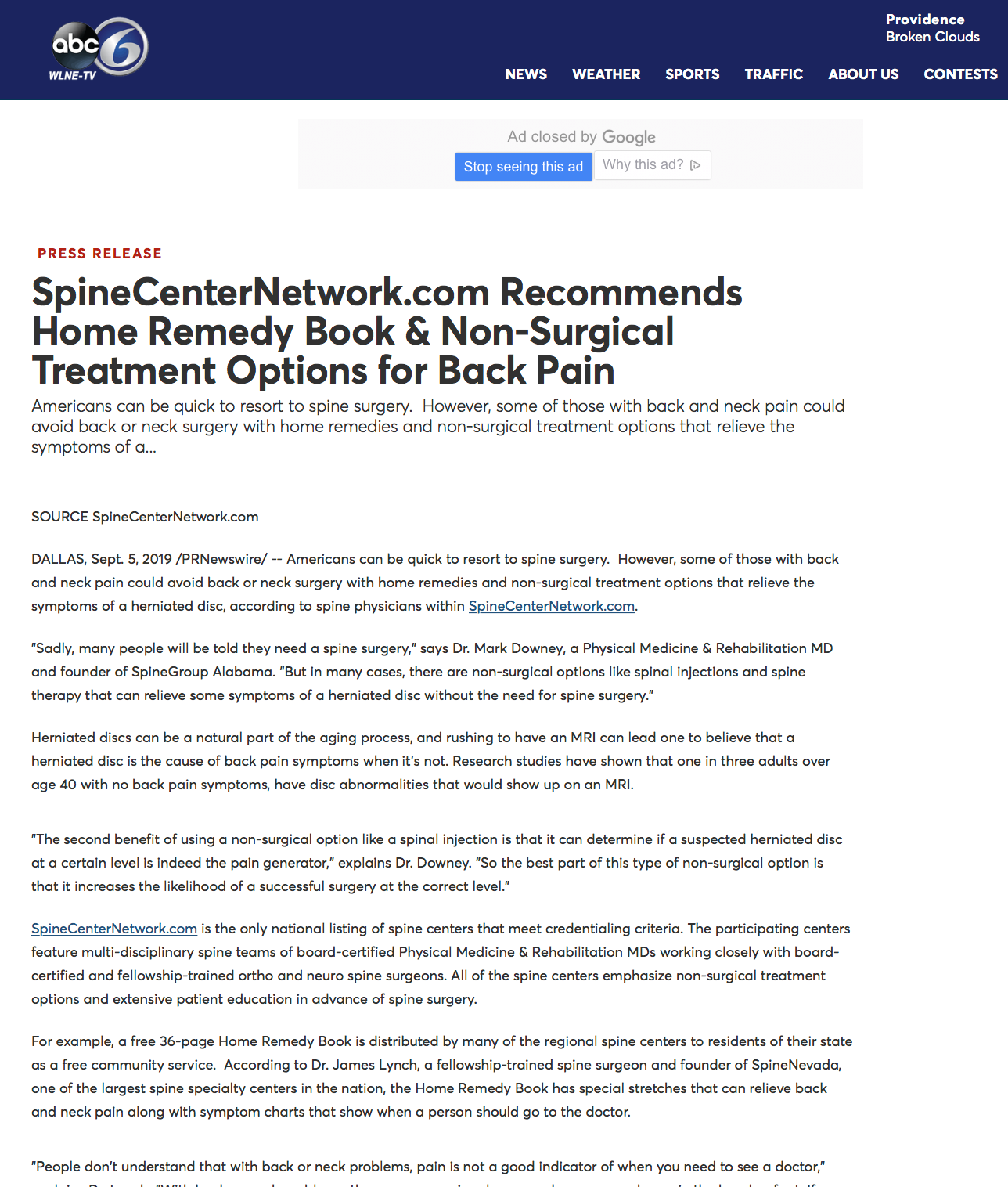 Spine Center Network was featured in more than 100 national media outlets in September 2019 related to advising those with back pain to exhaust non-surgical treatment options before resorting to spine surgery.
Spine Center Network was featured in more than 100 national media outlets in September 2019 related to advising those with back pain to exhaust non-surgical treatment options before resorting to spine surgery.
Spine Center Network features on a U.S. map regional spine centers of excellence that emphasize a multidisciplinary spine center approach to back and neck pain. All the spine centers emphasize non-surgical treatment before spine surgery, and have a heavy emphasis on patient education.
All the spine centers list on SpineCenterNetwork.com, for example, distribute a free 36-page book that has home remedies for back pain and home remedies for neck pain.
Americans can be quick to resort to spine surgery. However, some of those with back and neck pain could avoid back or neck surgery with home remedies and non-surgical treatment options that relieve the symptoms of a herniated disc, according to spine physicians within SpineCenterNetwork.com.
"Sadly, many people will be told they need a spine surgery," says Dr. Mark Downey, a Physical Medicine & Rehabilitation MD and founder of SpineGroup Alabama. "But in many cases, there are non-surgical options like spinal injections and spine therapy that can relieve some symptoms of a herniated disc without the need for spine surgery."
Herniated discs can be a natural part of the aging process, and rushing to have an MRI can lead one to believe that a herniated disc is the cause of back pain symptoms when it’s not. Research studies have shown that one in three adults over age 40 with no back pain symptoms, have disc abnormalities that would show up on an MRI.
"The second benefit of using a non-surgical option like a spinal injection is that it can determine if a suspected herniated disc at a certain level is indeed the pain generator," explains Dr. Downey. "So the best part of this type of non-surgical option is that it increases the likelihood of a successful surgery at the correct level."
April 29, 2019 — Spine Center Network provides important advice on when to consider artificial disc replacement
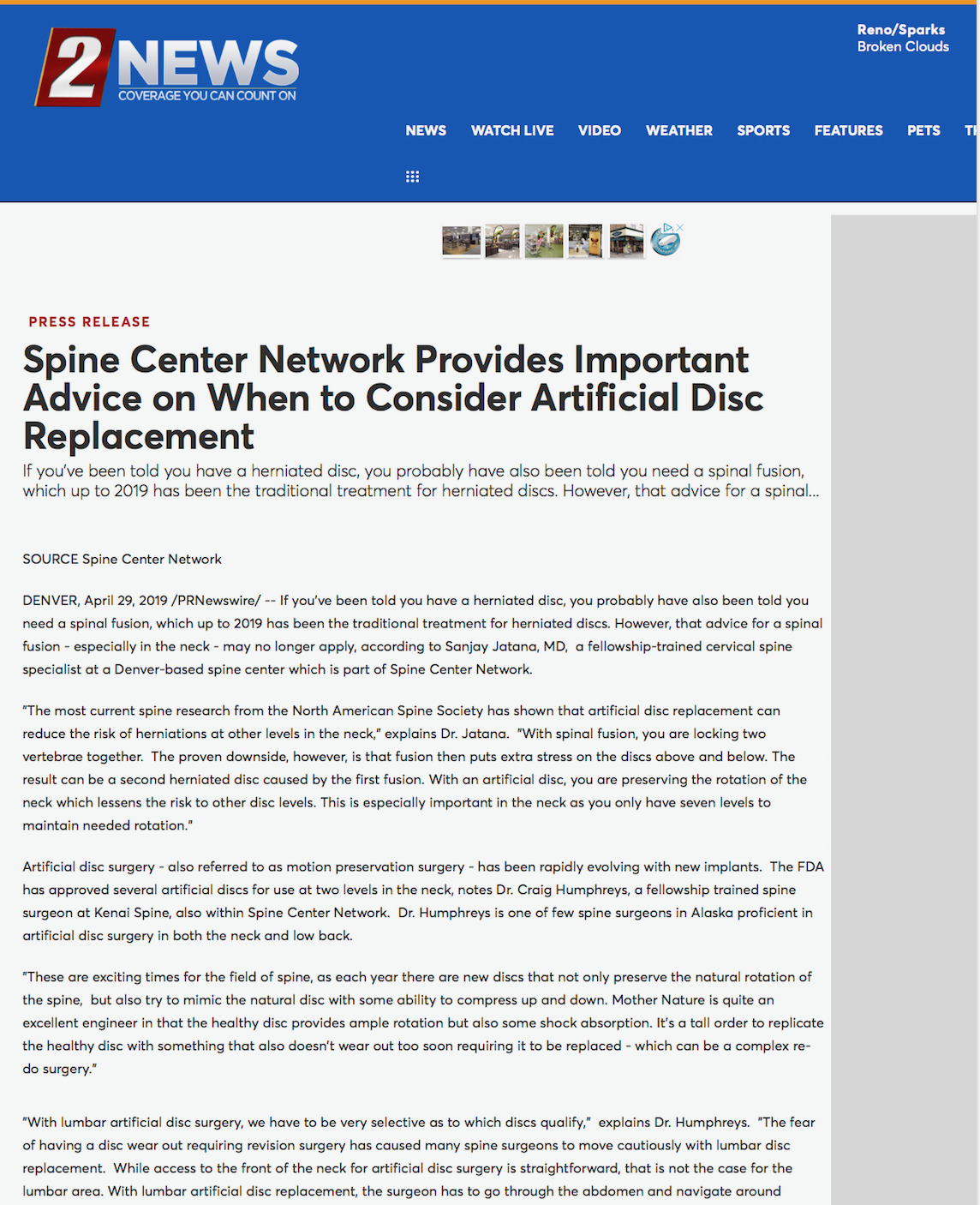 SpineCenterNetwork.com was featured in the national media in April 2019 related to advising patients on the latest technology for spine — the artificial disc.
SpineCenterNetwork.com was featured in the national media in April 2019 related to advising patients on the latest technology for spine — the artificial disc.
"If you’ve been told you have a herniated disc, you probably have also been told you need a spinal fusion, which up to 2019 has been the traditional treatment for herniated discs," explains Bob Reznik, MBA, President of Prizm Development and an author of several books on healthcare subjects. "However, depending upon which doctor you see you might never learn that there is a more advanced option that keeps the natural motion in your neck, rather than locking two vertebrae together."
"The most current spine research from the North American Spine Society has shown that artificial disc replacement can reduce the risk of herniations at other levels in the neck," explains Dr. Jatana, a Denver, Colorado spine surgeon who specializes exclusively in neck surgery and motion preservation surgery for the neck. "With spinal fusion, you are locking two vertebrae together. The proven downside, however, is that fusion then puts extra stress on the discs above and below. The result can be a second herniated disc caused by the first fusion. With an artificial disc, you are preserving the rotation of the neck which lessens the risk to other disc levels. This is especially important in the neck as you only have seven levels to maintain needed rotation."
Artificial disc surgery — also referred to as motion preservation surgery — has been rapidly evolving with new implants. The FDA has approved several artificial discs for use at two levels in the neck, notes Dr. Craig Humphreys, a fellowship trained spine surgeon at Kenai Spine, also within Spine Center Network. Dr. Humphreys is one of few spine surgeons in Alaska proficient in artificial disc surgery in both the neck and low back.
September 11, 2015 - Bob Reznik, President of Prizm Development and Founder of Spine Center Network, was featured in Becker's Spine Review article on trends in spine center development and pain management centers.
8 ways to prepare your spine or pain care program for 2016
1. Be ready to position your product long term so that it can be rewarded more for doing less.
2. Insulate yourself into the back pain business for the futureworld, rather than just the spine surgery business.
3. Tighten your relationship with an Ambulatory Surgery Center that is geared for minimally invasive spine surgery and spinal injections.
4. Create and install ancillary revenue streams that can soften the impact of reimbursement reductions and increasing overhead.
5. Evolve your bundled case rate packages to include non-surgical triage and treatment options.
6. Provide exclusion criteria for problem patients.
7. Become the expert source for information on the subject of back and neck pain.
8. Go direct to to the consumer.
Click here to read the complete article on the Becker's Spine Review website, or download a PDF here.
Prizm featured at annual Neuroscience and Spine Centers of Excellence Conference in Chattanooga
On October 8, 2015 Bob Reznik, President of Prizm, was asked to speak at the annual Neuroscience and Spine Centers of Excellence Conference in Chattanooga, Tennessee. Bob Reznik, MBA, was asked to present on the subject of HOW TO DEVELOP A DESTINATION FOR SPINE CARE IN THE CURRENT HEALTHCARE REFORM ENVIRONMENT. Conference attendees learned:
• How to develop a spine care PRODUCT that appeals to, consumers employers, case managers and payers. What to include and, more importantly,what to exclude.
• How to PLACE the product in the marketplace with a spine center facility that is unique and consolidates a team of specialists and key components under one roof.
• How to POSITION the spine center as superior to competitors and establish barriers to entry to competitors.
How to PRICE spine care with case rates for spine surgery, spinal injections and non-surgical episodes of care.
• How to PROMOTE the destination center on the Internet, through direct-to-consumer promotion and referral development to attract patients from a 300 mile radius.
• Trap doors to failure: Why some spine centers fail to grow.
South Carolina Spine Center added to SpineCenterNetwork.com
In 2013, Self Regional Healthcare called upon Prizm to help them improve how they manage back and neck pain through their spine center service line. The spine program at that time included three fellowship-trained spine neurosurgeons. Over 2014 and 2015, Prizm helped the spine service line to mature into a more complete multi-disciplinary spine center with two specialists in Physical Medicine and Rehabilitation (PMR), and a better-integrated spine therapy department. "The spine center now is proficient in managing those back and neck pain cases that don't need surgery," explains Bob Reznik, MBA. "The PMR specialists manage the non-surgical treatment options and triage those patients who need surgery more adroitly to the specialists. Now everything related to spine is in one location for the convenience of the person with back or neck pain: diagnostics, X-ray, MRI, spine surgeons, MDs who specialize in non-surgical treatment and spinal injections and therapy. It's now a true destination center for spine care that attracts patients from a 100 mile radius." In 2014, South Carolina Spine Center met the credentialing criteria to be included in SpineCenterNetwork.com, the only national listing of credentialed spine centers.
Hospitals and health systems view spine care as an essential service line for the future
While most of general orthopedics and several other surgical specialties have migrated off campus into Ambulatory Surgery Centers, spine care is one of the few service lines that is essential to the health of a hospital and health system. Consequently, Prizm is increasingly contacted by hospitals in 2015 wanting to explore what's involved with creating a regional destination for spine care. "While more minimally invasive spine surgery lends itself to being done in an ambulatory surgery center so patients can be home later the same day, typically the majority of spine surgery can require an overnight stay in the hospital," explains Bob Reznik, MBA. "Hospitals and health systems recognize that spine care is an essential service line for the future. While they start exploring spine with a surgical orientation, they soon realize however that consumers - and referral sources - are educated to pursue non-surgical treatment options in advance of surgery. The days of the surgical mill are dead. So a hospital must develop a comprehensive program with pain care specialists and spine therapists working as a multi-disciplinary spine care team."
Growth at Prizm-developed spine centers provides opportunities for new spine surgeons and physical medicine specialists
2015 and 2016 can be a turbulent healthcare reform environment to enter as a physician leaves residency or fellowship as a new spine surgeon or pain care specialist. Thankfully, new fellowship-trained spine surgeons and pain specialists can contact Prizm to explore some locations that are growing and need additional physicians for the spine care team.
Prizm speaks at Becker's 13th annual Spine, Orthopedic & Pain Care Conference in Chicago
Prizm was invited to speak at the 13th Annual Spine, Orthopedic and Pain Management-Driven Conference held at the Westin Hotel in downtown Chicago on June 12, 2015. Bob Reznik, MBA, president of Prizm Development presented current methodologies for developing a regional destination center for spine care. This included an overview of how to generate physician referrals to a regional spine center in an environment where more primary care physicians are being employed by hospitals. The presentation also offered guidelines for educational direct-to-consumer promotion that helps those with spine problems and pain issues understand more about their symptoms. This can include the development of symptom charts that enable people to know when it's important to see the physician quickly for emergent problems like neurological deficit, and when home remedies may be used safely for simple acute back or neck strain.
Prizm helps fellowship-trained spine surgeon develop a regional spine center in Alaska
Dr. Craig Humphreys, a fellowship-trained spine surgeon, wanted to finish his career in spine where he grew up - in Alaska. He and Central Peninsula Hopital called on Prizm to help develop a regional spine center in Alaska. The center now acts as a regional referral center for back and neck pain patients, many driving the three hours from Anchorage to reach the spine center. Kenai Spine, now in its third year, is located in a freestanding spine center location on the Kenai Peninsula, and includes a Mayo Clinic-trained specialist in Physical Medicine & Rehabilitation for non-surgical treatment options, including spinal injections. The Alaska spine center also includes internal X-ray and spine therapy. For spine surgery, Central Peninsula Hospital provides the advanced O-arm surgical navigation technology.
Prizm helps fellowship-trained spine surgeon position his spine program for the future
Dr. Michael Rohan Jr., a fellowship-trained spine surgeon who trained at Texas Back Institute, called on Prizm to help his spine program get to the next level. Prizm re-tooled all referral development and direct-to-consumer communication along developing one of the most educational spine Internet sites in the State of Florida. Panama City Spine now receives referrals from a 100 mile radius around the Florida Panhandle and Gulf Coast.
Prizm offers Marketing, Promotion Tips For Spine Centers
At the 12th Annual Spine, Orthopedic and Pain Management-Driven Conference in Chicago on June 13, 2015, Bob Reznik, MBA, president of Prizm Development provided three key tips on spine center promotion and marketing.
Mr. Reznik's discussion on marketing and promotion for spine centers included the following topics: the importance of educating the consumer, sending the right message and maintaining a strong Internet presence. Read more about this session and the Annual Spine conference, please click here.Most Respected Developer of Spine Centers Offers Ideas for Marketing Spine
During a presentation at Becker's ASC Review's 12th Annual Spine, Orthopedic and Pain Management-Driven ASC Conference + the Future of Spine, June 12 in Chicago, Jimmy St. Louis, CEO of Regenerative Medicine Solutions, Bob Reznik, president of Prizm Development and Daniel Goldberg, CEO and creative director of Gold Medal Marketing, shared four ideas for marketing spine surgery practices in an increasingly competitive market. The session was moderated by Peter Cunningham, founder and COO of CCO Healthcare Partners. Four topics discussed during the session included Accentuate Differences, Identify Targeted Populations and Market to Them, Don't Overvalue Social Media and Market to Employers.
Spine center concept developed by Prizm featured by Becker's Spine Review in article highlighting the future of spine care
September 19, 2013-- Prizm Development's model of spine center involving non-surgical physicians and spine surgeons working together spotlighted in Becker's article entitled "Will Spine Surgeons Need Non-Surgical Partners in the Future? 6 Things to Know."
Dr. James Lynch, a fellowship-trained neurosurgeon and founder of SpineNevada explains how the Prizm model is attractive to national payers. SpineNevada was developed nearly ten years ago and involves fellowship-trained neurosurgeons, physical medicine physicians along with spine physical therapists. The spine center tracks clinical outcomes and distributes clinical outcome results to health insurance companies and referral sources. Click here to read the complete Becker's article.
8 Key Ingredients for True Spine Centers of Excellence
July 26, 2013-- Bob Reznik, President of Prizm Development and Founder of Spine Center Network featured in Becker's Spine Review article discussing the key elements of true spine centers of excellence.
Bob Reznik, President of Prizm Development, discusses the key elements of true spine centers of excellence. The key ingredients include:
1. Interconnect specialists for constant communication
2.
Concentrate on core components for payers to take you seriously
3.
Make the physical medicine and rehabilitation specialist the gatekeeper
4.
Construct an ambulatory surgery center
5.
Develop a protocol for patients
6. Measure clinical outcomes
7. Emphasize exercise and movement with patients
8. Assign a clinical coordinator to follow up with patients
Click here to read the complete article on the Becker's Spine Review website.
Prizm Spine Centers named to list of 2013 Spine Surgery Practices to Know by Becker's Spine Review
June 26, 2013-- The following Prizm Development spine centers have been selected to list of 105 independent spine surgery practices to know by Becker's Spine Review.
Ann Arbor (Mich.) Spine Center
Black Hills Neurosurgery & Spine (Rapid City, S.D.)
Bristol Neurosurgical Associates (Bristol, Tenn.) TriCities Spine
Denver Spine Surgeons (Greenwood Village, Colo.).
Georgia Comprehensive Spine (Athens)
North Jersey Spine Group (Wayne, N.J.).
Seton Spine & Scoliosis Center (Austin, Texas)
South Bend Spine (Mishawaka, Ind.)
Spine Colorado (Durango)
Spine Group Beverly Hills (Beverly Hills, CA)
SpineNevada Minimally Invasive Spine Institute (Reno, NV)
Summit Spinecare (Woodbury, Minn.)
Click here to read the complete list on the Becker's Spine Review website.
5 Qualities of Spine Center Leaders for Today & Tomorrow
April 10, 2013-- Spine Center Network and Bob Reznik, MBA featured in Becker's Spine Review article entitled "5 Qualities of Spine Center Leaders for Today & Tomorrow"
Spine Center Network was developed by Prizm Development, Inc., two years ago and now acts as a national network of credentialed Spine Centers of Excellence for payors and consumers. Inclusion in the network is based on credentialing criteria that includes having fellowship-trained or highly specialized spine surgeons integrated with spine-specialized physical medicine physicians and spine therapists. Spine Center Network represents those spine centers that meet the credentialing criteria. It currently includes about 18 spine centers across the United States. Read the complete article here, new window will open. Click here to read article on Becker's Spine Review.
Disclaimer:
The pictures displayed in this website are images of physicians, patients and employees who have consented to have their pictures in this website. If you are viewing in Internet Explorer 8 or older you may need to update your browser.
RELATED TOPICS
About Us Awards Staff Medical Marketing References Case Study Published Books In the News Spine Center NetworkHAVE A QUESTION?
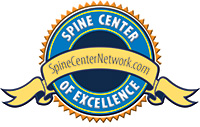
Wouldn’t it be convenient if someone created a listing of spine centers of excellence across the United States that all emphasize non-surgical treatment options before surgery?
Finally, there is a place.
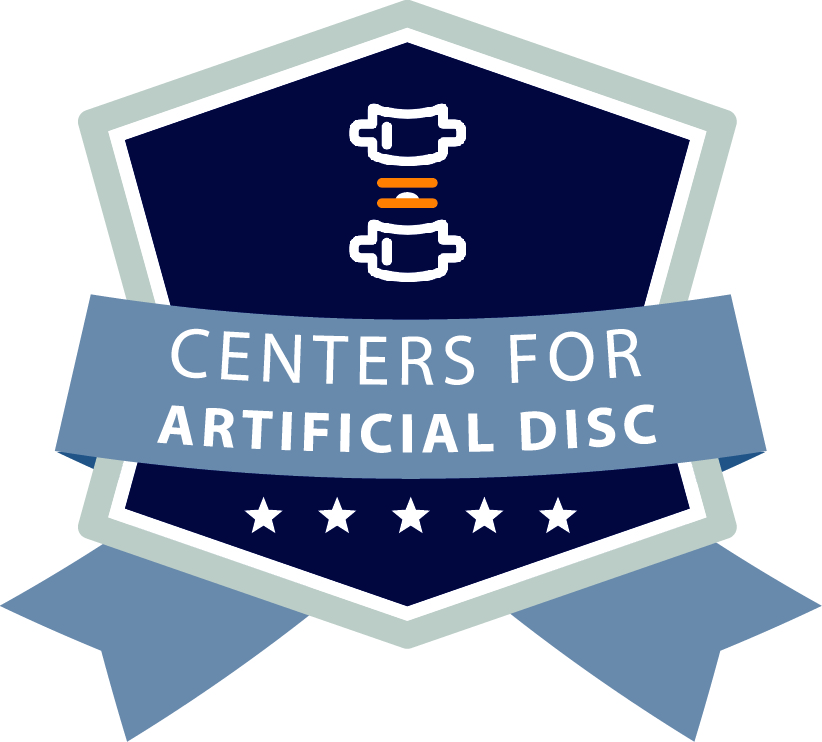
Centers for Artificial Disc is the only verified national listing of spine centers that specialize in artificial disc replacement surgery.
CentersForArtificialDisc.com